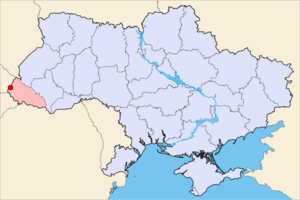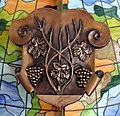Uzhhorod
| Uzhhorod | |||
| |||
| Motto: | |||

| |||
|---|---|---|---|
| Oblast | Zakarpattia Oblast | ||
| Mayor | Sergiy Ratushnyak | ||
| Area | 31.56 kм² | ||
| Population - city - density |
111,300 (2004) 3,662 /km² | ||
| Founded |
9th Century | ||
| Latitude Longitude |
48°37′N 22°18′E / 48.617°N 22.300°E | ||
| Area code | +380 312 | ||
| sister cities | Békéscsaba, Nyíregyháza, Moscow, Orel, Pula, Corvallis, Oregon, Darmstadt, | ||
| [Municipal Website] | |||
Uzhhorod (Ukrainian and Russian: Ужгород; in Ruthenian: Уґоград;Slovak and Czech: Užhorod; Hungarian: Ungvár; German: Ungwar; Yiddish: אונגװיר, Ungvir, Ingver, Yngvyr) is a city in Ukraine, at the border with Slovakia. Uzhhorod is the centre city of Zakarpattia Oblast, the westernmost oblast of Ukraine.
The city gets its name from the Uzh River, which divides the city into two halves (the old and new sections). Uzh (Уж) means eel, and horod (город) is Ruthenian for city, coming from Old Slavonic gradъ (градъ).
The city is spelled Ужгород in both Ukrainian and Russian, transliterated "Uzhhorod" from Ukrainian, "Uzhgorod" from Russian. Consequently, the city has been widely known in English language context as Uzhgorod during the Soviet Union era.
Uzhhorod is located at 48°37′N 22°18′E / 48.617°N 22.300°E, population is 111,300 (2004).
History

now Philharmonic Orchestra
The best known of the first city founders are the Slavs. One of their tribes – White Croats – settled the area of the modern Uzhgorod in the second half of the first Millennium AD. During the 9th century a fortified castle changed into a fortified early feudal town-settlement, which became the centre of a new Slavonic principality, at the head of which was a legendary prince Laborets.
In 903 AD Hungarian tribes, headed by their leader Árpád, stormed the Hungvar fortress. The forces were not equal and Laborets was defeated.
After the arrival of the Hungarians, the small town began to extend its borders. In 1241–1242 the Tatars of Batu-khan burnt the settlement. In the early 14th century Uzhhorod showed a strong resistance to the new Hungarian rulers of the Anjou dynasty. From 1318 for 360 years long the Druhetts (Italian Counts) had owned the town. During that period Philip Druhett built a new stone fortress on the place of the modern castle. Together with the castle the city began to grow. Already in 1430 Uzhgorod acquired some privileges from the king and was officially called “The Privileged City of Uzhgorod”
During the 16–17th centuries there were many handicraft corporations in Uzhgorod. In that period the city was engaged in the religious fight between Protestant Transylvania and Catholic Austria. In 1646 in the Uzhgorod castle by the Vatican Aegis the Uzhgorod Union was proclaimed and the Greek-Catholic church was established in Subcarpathia. In 1707 Uzhgorod was the residence of Ferenc II Rákóczi, the leader of the national-liberation war of the Hungarian people.
The beginning of the 19th century is characterized by economic changes. There appeared the first factories in Uzhgorod. The greatest influence on Uzhgorod among the political events of the 19th century was made by the Hungarian revolution, during which Hungarian nobility to assert their right to dominate all other peoples of Hungary, especialy the Slavs who the Hungarians view with particular prejudice. (1848–1849.) March 27, 1848 was officially celebrated in the city as the overthrow of the monarchy in Hungary. In 1872 the first railway "Uzhgorod–Chop" began to work.
The First World War slowed down the tempo of the city development. In September 10, 1919 Subcarpathia was officially annexed to the Republic of Czechoslovakia. Uzhgorod became the administrative centre of the territory. During these years Uzhgorod developed into an architecturally modern city. After the Munich Treaty Uzhgorod became part of the Slovak half of the new Czecho-Slovak state.
After the Vienna Award in 1938 Uzhgorod was transferred to Hungary. Till the end of 1944 the fights of the Second World War came close to Uzhgorod. On October 27, 1944 the city was liberated by the troops of the Fourth Ukrainian Front.
The liberation period brought the significant changes. At the outskirts of Uzhgorod new enterprises were constructed and the old enterprises were renewed. On Juny 29, 1945 Subcarpathian Ukraine (Закарпатська Україна) became a part of the Ukrainian SSR of the USSR. That year the Uzhgorod State (nowadays - National) University was also opened. Since January 1946 Uzhgorod was the centre of newly formed Zakarpatska oblast.
Since 1991 Uzhgorod has become one of 23 regional capitals within Ukraine. Of these, Uzhgorod is the smallest and westernmost.
Twinning
Uzhhorod is twinned with:
 Békéscsaba, Hungary
Békéscsaba, Hungary Nyíregyháza, Hungary
Nyíregyháza, Hungary Moscow, Russia
Moscow, Russia Orel, Russia
Orel, Russia Pula, Croatia
Pula, Croatia Corvallis, Oregon, USA
Corvallis, Oregon, USA Darmstadt, Germany
Darmstadt, Germany Košice, Slovakia
Košice, Slovakia
People
- Shlomo Ganzfried, an Orthodox rabbi and posek
- Samuel Lipschütz, a chess player and author
- János Erdélyi, a Hungarian poet, critic, author, philosopher and ethnographist
- Mikhail Kopelman, a Ukrainian violinist
- Avhustyn Voloshyn, a Subcarpathian politician, teacher, and essayist
- Józef Kasparek, a Polish lawyer, historian and political scientist
